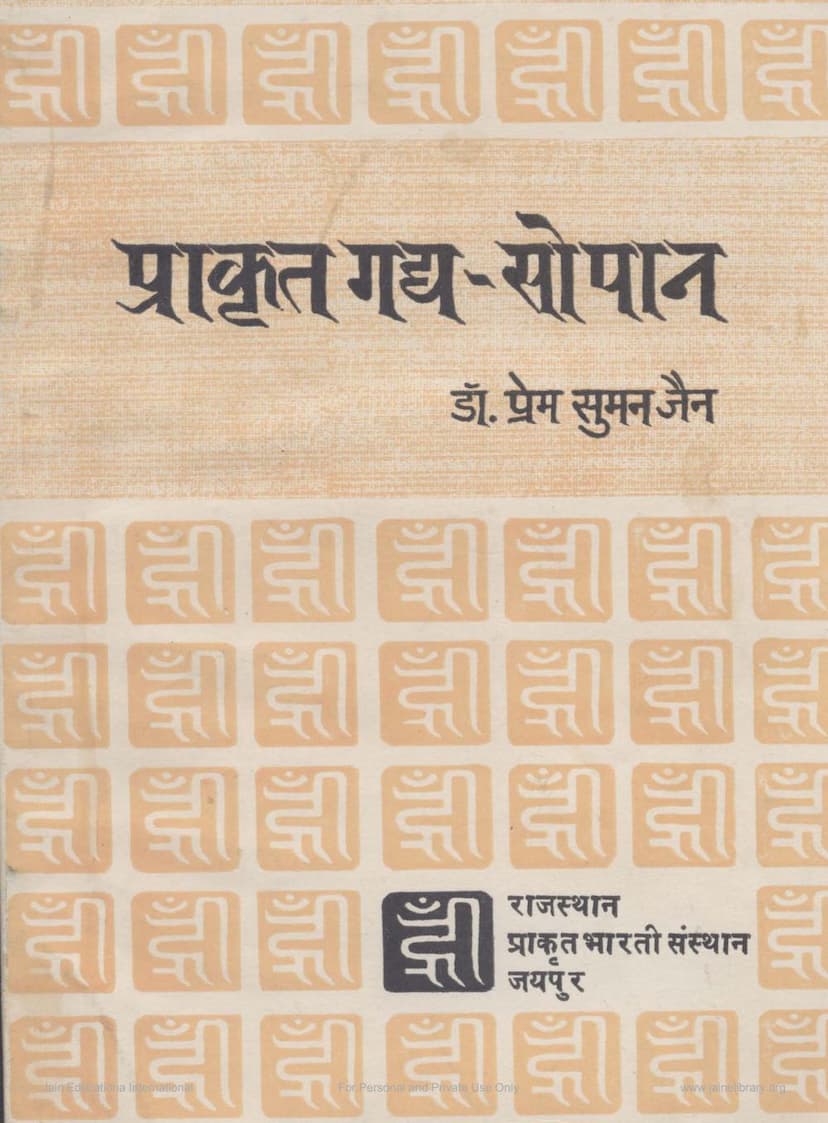Prakrit Gadya Sopan
Added to library: September 2, 2025

Summary
This is a comprehensive summary of the Jain text "Prakrit Gadya Sopana" by Prem Suman Jain, based on the provided pages and catalog link:
Book Title: Prakrit Gadya Sopana (प्राकृत गद्य-सोपान)
Author: Dr. Prem Suman Jain
Publisher: Rajasthan Prakrit Bharti Sansthan, Jaipur
Publication Year: 1983 (First Edition)
Catalog Link: https://jainqq.org/explore/003807/1
Overall Purpose and Content:
"Prakrit Gadya Sopana" is a textbook designed for students to learn and appreciate Prakrit prose literature. The book aims to introduce readers to various forms of Prakrit prose through carefully selected passages. It serves as an educational resource for secondary and undergraduate levels, and can also be used by religious educational institutions for introductory Prakrit studies. The text emphasizes not only the language and literary aspects but also aims to impart universal moral and ethical values found in Prakrit literature, making it accessible and inspiring for any reader, regardless of their background.
Key Features and Structure:
The book is structured into several sections:
-
(क) Prakrit Grammar Practice (प्राकृत व्याकरण-अभ्यास): This section focuses on the grammatical aspects of Prakrit, specifically targeting the understanding and application of different cases (विभक्ति) and their rules. It includes exercises and example sentences for:
- Shashthi Vibhakti (षष्ठी विभक्ति - Genitive Case): Explaining the use of the genitive case, particularly for possession and relationship, with examples like "गिह-उववनं" (house, garden).
- Dwitiya Vibhakti (द्वितीया विभक्ति - Accusative Case): Focusing on the accusative case, used for direct objects and with certain prepositions/adverbs, illustrated with examples like "कुडुम्बं" (family) and "पभायवेला" (morning time).
- Saptami Vibhakti (सप्तमी विभक्ति - Locative Case): Explaining the locative case, used for location and in relation to words indicating affection, belief, etc., with examples like "गुणगरिमा" (glory of qualities).
- Tritiya Vibhakti (तृतीया विभक्ति - Instrumental Case): Covering the instrumental case, used for the agent, instrument, or with companion words, shown in examples like "दिणचरिया" (daily routine).
- Chaturthi Vibhakti (चतुर्थी विभक्ति - Dative Case): Explaining the dative case, used for the indirect object or purpose, with examples like "सरोवरं" (lake).
- Panchami Vibhakti (पंचमी विभक्ति - Ablative Case): Detailing the ablative case, used for separation, source, fear, or comparison, illustrated with "लोअ-मरूवं" (form of the world).
- Grammatical Rules: The section also includes specific rules for noun and pronoun declensions in the genitive, dative, accusative, locative, instrumental, and ablative cases in Prakrit.
-
(ख) Prakrit Prose Collection (प्राकृत गद्य-संग्रह): This is the core of the book, presenting a curated selection of Prakrit prose passages. These passages are representative of significant Prakrit literary works and are arranged chronologically. The selections aim to be:
- Representative: Drawing from key Prakrit prose genres, including Agam literature, narrative literature, biographical accounts, dramas, and inscriptions.
- Simple, Universal, and Educational: The chosen texts are designed to be easily understood while conveying universal ethical values.
- Illustrative of Prakrit Literature: The collection covers various themes, such as:
- Moral teachings from Agam texts (e.g., "विद्याविहीनो नश्यति" - The unlearned perishes, "प्रमादस्य दोषो" - The fault of negligence).
- Inspirational stories of great personalities and virtuous, courageous, and compassionate women.
- Simple expressions of everyday life.
- Texts reinforcing life values like non-violence, friendship, philanthropy, courage, and effort.
- Specific Text Examples (from the index): The collection includes excerpts from texts like Uttaradhyayana Tikka, Jñātādharmakathā, Antakṛtdaśā, Niśītha Vṛtti, Daśavaikālika Cūrṇi, Vasudevahiṇḍī, Samrāiccakathā, Utpannapauruṣacarita, Manoramakathā, Kuvalayamālakathā, Mr̥cchakaṭika, Abhijñānaśākuntala, Karpūramañjarī, etc.
-
(ग) Prakrit Language and Literature (प्राकृत भाषा एवं साहित्य): This section provides an overview of Prakrit language and its literary history.
- Introduction to Prakrit Languages: Discusses the various Prakrit languages (e.g., Ardhamāgadhī, Śaurasenī, Māhārāṣṭrī, Māgadhī, Paiśācī).
- Outline of Prakrit Prose Literature: Details the evolution and characteristics of Prakrit prose across different genres like Āgama, Kathā, Carita, Nāṭaka, and inscription literature.
-
(घ) Appendix (परिशिष्ट): This section contains supplementary material for the learner.
- Hindi Translation of Prose Passages: Provides Hindi translations for the Prakrit prose selections, aiding comprehension.
- Unseen Prakrit Prose Passage: An exercise for students to test their understanding and translation skills.
Key Themes and Values:
The book implicitly and explicitly promotes several important values:
- Ethical Conduct: Many passages emphasize honesty, diligence, compassion, and the importance of good deeds.
- Moral Development: The stories aim to cultivate character, illustrating the consequences of negative actions (like greed, envy, and pride) and the rewards of virtuous living.
- Respect for Elders and Gurus: Several stories highlight the importance of respecting teachers and elders.
- Non-Violence (Ahimsa): The Jain context naturally brings forth the principle of non-violence, evident in stories emphasizing compassion for all living beings.
- Perseverance and Effort: Stories often show characters achieving success through hard work and determination.
Educational Significance:
- Structured Learning: The book offers a systematic approach to learning Prakrit, starting with grammar and progressing to prose literature.
- Comprehensive Coverage: It covers a wide range of Prakrit prose, offering a good foundation for students.
- Cultural and Spiritual Insight: It provides access to the rich cultural and spiritual heritage embedded in Jain and Prakrit literature.
- Accessibility: The inclusion of Hindi translations and exercises makes the study of Prakrit more accessible to a broader audience.
Publisher's Note (प्रकाशकीय):
The publisher's note highlights the 25th publication of the Prakrit Bharti Sansthan, emphasizing their commitment to promoting Prakrit language and literature. They express pleasure in publishing Dr. Prem Suman Jain's work, noting that it complements their previously published books like "Prakrit Swayam-Shikshak" and "Prakrit Kavya-Manjari." The note specifically mentions that "Prakrit Gadya-Sopana" aligns with the Prakrit curriculum for classes 9 and 10 set by the Ajmer Board of Secondary Education, and that these books can be utilized by other state boards as well. The publisher also acknowledges the book's ability to impart knowledge of Indian life values.
In essence, "Prakrit Gadya Sopana" is a well-structured and valuable resource for anyone wishing to learn and engage with the beauty and wisdom of Prakrit prose, particularly within the Jain tradition.